Anatomy Assignment: Exploring Human Body Systems and Functions
VerifiedAdded on 2023/06/10
|8
|1150
|395
Homework Assignment
AI Summary
This assignment provides a comprehensive overview of ten major human body systems: the musculoskeletal, circulatory, respiratory, skeletal, integumentary, central nervous, digestive, endocrine, urinary, and genital systems. Each system is described in terms of its primary function, major parts, and how it works, followed by a discussion of potential disorders. The assignment covers the role of the musculoskeletal system in movement and support; the circulatory system in blood circulation and transport; the respiratory system in gas exchange; the skeletal system in providing an internal framework; the integumentary system in protection; the central nervous system in coordination; the digestive system in food breakdown; the endocrine system in hormone transport; the urinary system in waste elimination; and the genital system in sexual reproduction. The assignment concludes with a list of references, providing a solid foundation for understanding the human anatomy and physiology.
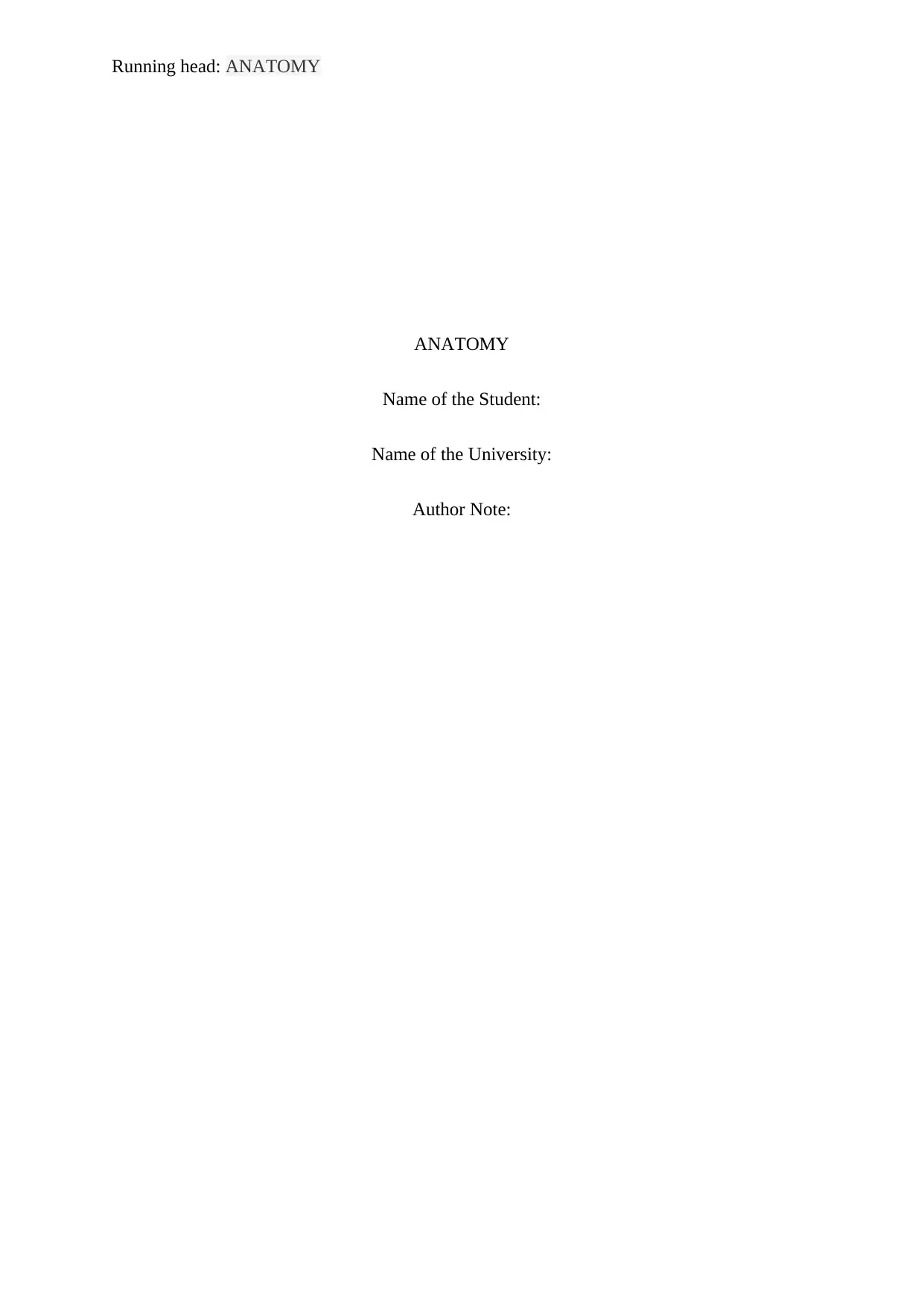
Running head: ANATOMY
ANATOMY
Name of the Student:
Name of the University:
Author Note:
ANATOMY
Name of the Student:
Name of the University:
Author Note:
Paraphrase This Document
Need a fresh take? Get an instant paraphrase of this document with our AI Paraphraser
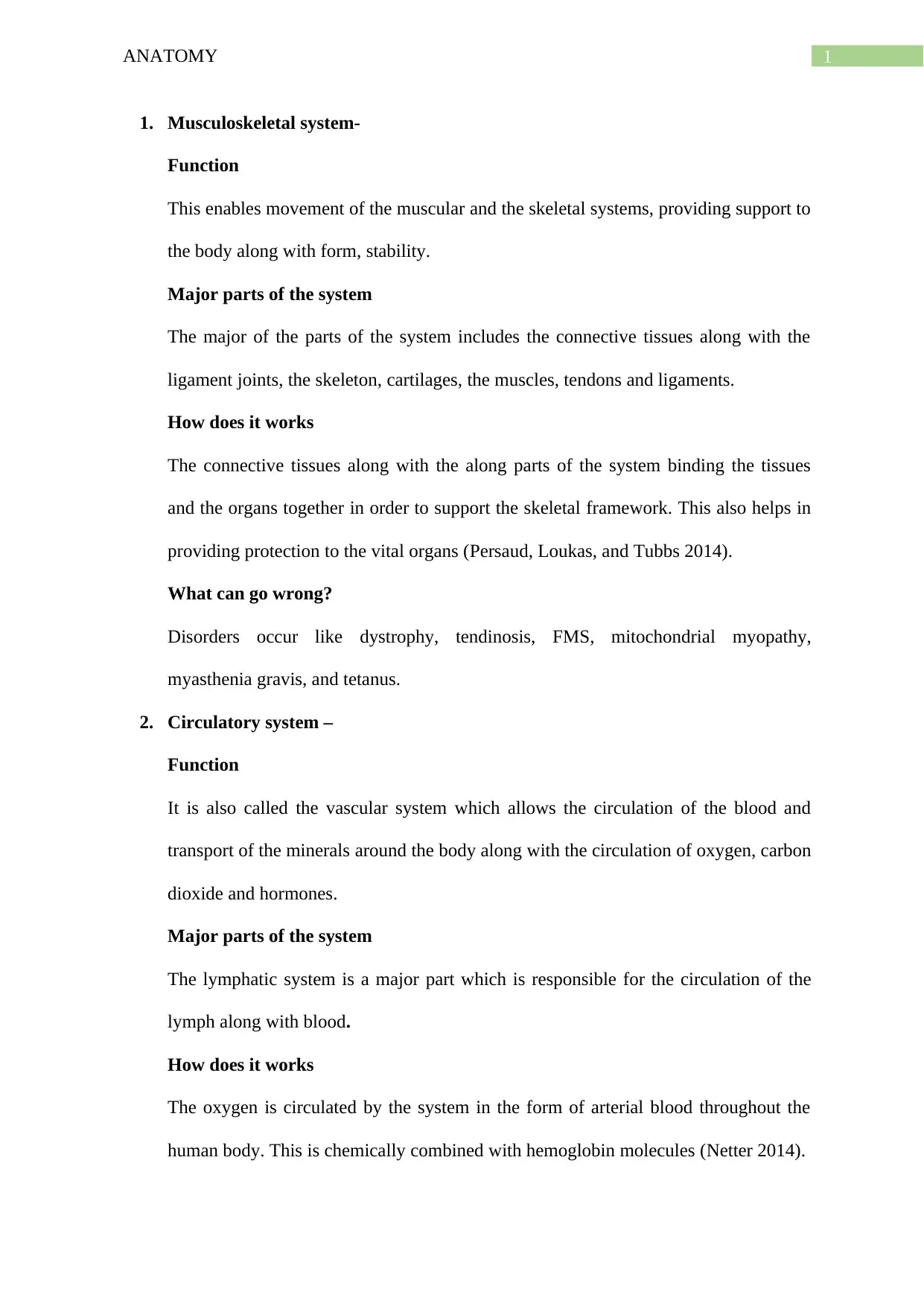
1ANATOMY
1. Musculoskeletal system-
Function
This enables movement of the muscular and the skeletal systems, providing support to
the body along with form, stability.
Major parts of the system
The major of the parts of the system includes the connective tissues along with the
ligament joints, the skeleton, cartilages, the muscles, tendons and ligaments.
How does it works
The connective tissues along with the along parts of the system binding the tissues
and the organs together in order to support the skeletal framework. This also helps in
providing protection to the vital organs (Persaud, Loukas, and Tubbs 2014).
What can go wrong?
Disorders occur like dystrophy, tendinosis, FMS, mitochondrial myopathy,
myasthenia gravis, and tetanus.
2. Circulatory system –
Function
It is also called the vascular system which allows the circulation of the blood and
transport of the minerals around the body along with the circulation of oxygen, carbon
dioxide and hormones.
Major parts of the system
The lymphatic system is a major part which is responsible for the circulation of the
lymph along with blood.
How does it works
The oxygen is circulated by the system in the form of arterial blood throughout the
human body. This is chemically combined with hemoglobin molecules (Netter 2014).
1. Musculoskeletal system-
Function
This enables movement of the muscular and the skeletal systems, providing support to
the body along with form, stability.
Major parts of the system
The major of the parts of the system includes the connective tissues along with the
ligament joints, the skeleton, cartilages, the muscles, tendons and ligaments.
How does it works
The connective tissues along with the along parts of the system binding the tissues
and the organs together in order to support the skeletal framework. This also helps in
providing protection to the vital organs (Persaud, Loukas, and Tubbs 2014).
What can go wrong?
Disorders occur like dystrophy, tendinosis, FMS, mitochondrial myopathy,
myasthenia gravis, and tetanus.
2. Circulatory system –
Function
It is also called the vascular system which allows the circulation of the blood and
transport of the minerals around the body along with the circulation of oxygen, carbon
dioxide and hormones.
Major parts of the system
The lymphatic system is a major part which is responsible for the circulation of the
lymph along with blood.
How does it works
The oxygen is circulated by the system in the form of arterial blood throughout the
human body. This is chemically combined with hemoglobin molecules (Netter 2014).
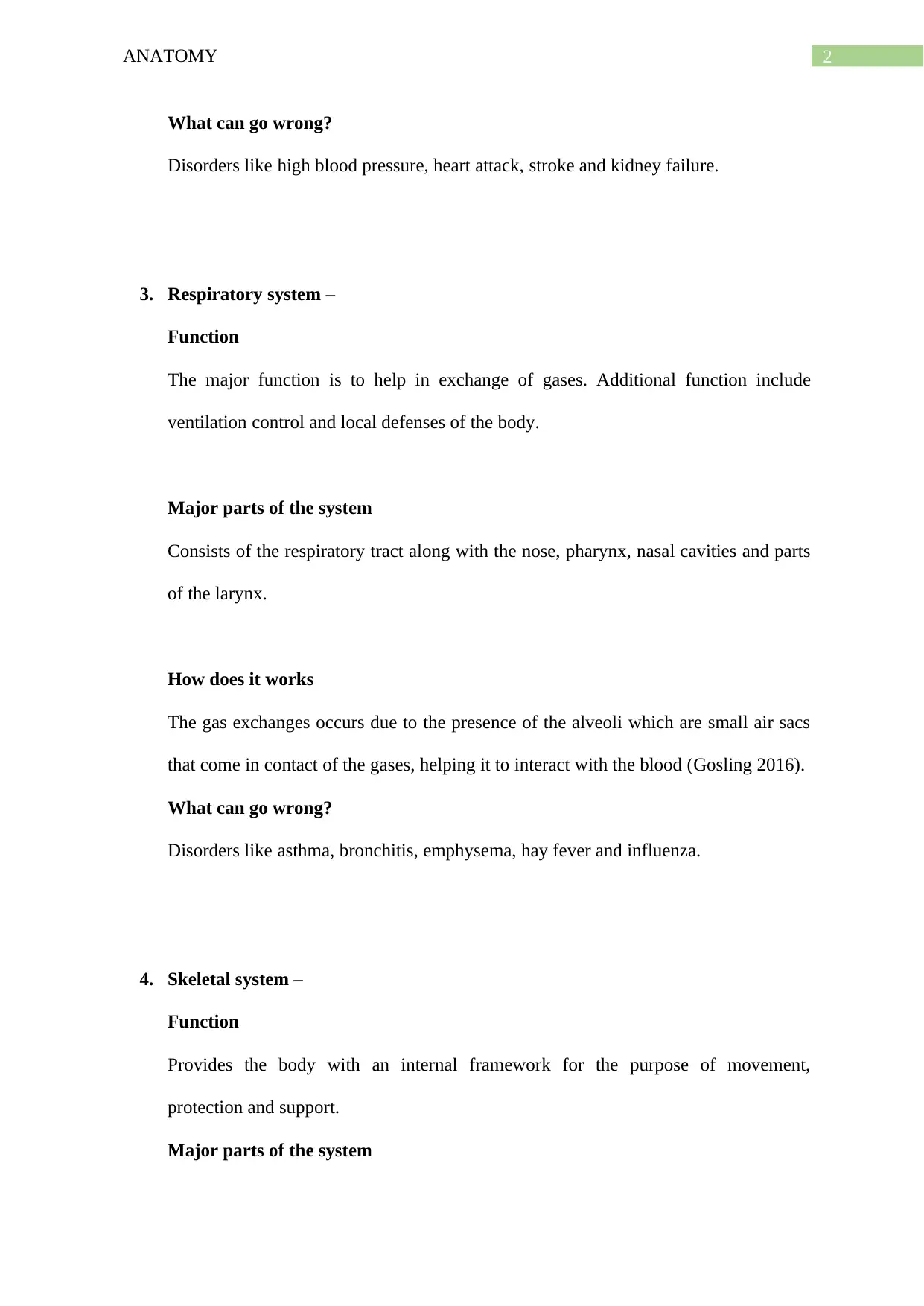
2ANATOMY
What can go wrong?
Disorders like high blood pressure, heart attack, stroke and kidney failure.
3. Respiratory system –
Function
The major function is to help in exchange of gases. Additional function include
ventilation control and local defenses of the body.
Major parts of the system
Consists of the respiratory tract along with the nose, pharynx, nasal cavities and parts
of the larynx.
How does it works
The gas exchanges occurs due to the presence of the alveoli which are small air sacs
that come in contact of the gases, helping it to interact with the blood (Gosling 2016).
What can go wrong?
Disorders like asthma, bronchitis, emphysema, hay fever and influenza.
4. Skeletal system –
Function
Provides the body with an internal framework for the purpose of movement,
protection and support.
Major parts of the system
What can go wrong?
Disorders like high blood pressure, heart attack, stroke and kidney failure.
3. Respiratory system –
Function
The major function is to help in exchange of gases. Additional function include
ventilation control and local defenses of the body.
Major parts of the system
Consists of the respiratory tract along with the nose, pharynx, nasal cavities and parts
of the larynx.
How does it works
The gas exchanges occurs due to the presence of the alveoli which are small air sacs
that come in contact of the gases, helping it to interact with the blood (Gosling 2016).
What can go wrong?
Disorders like asthma, bronchitis, emphysema, hay fever and influenza.
4. Skeletal system –
Function
Provides the body with an internal framework for the purpose of movement,
protection and support.
Major parts of the system
⊘ This is a preview!⊘
Do you want full access?
Subscribe today to unlock all pages.

Trusted by 1+ million students worldwide
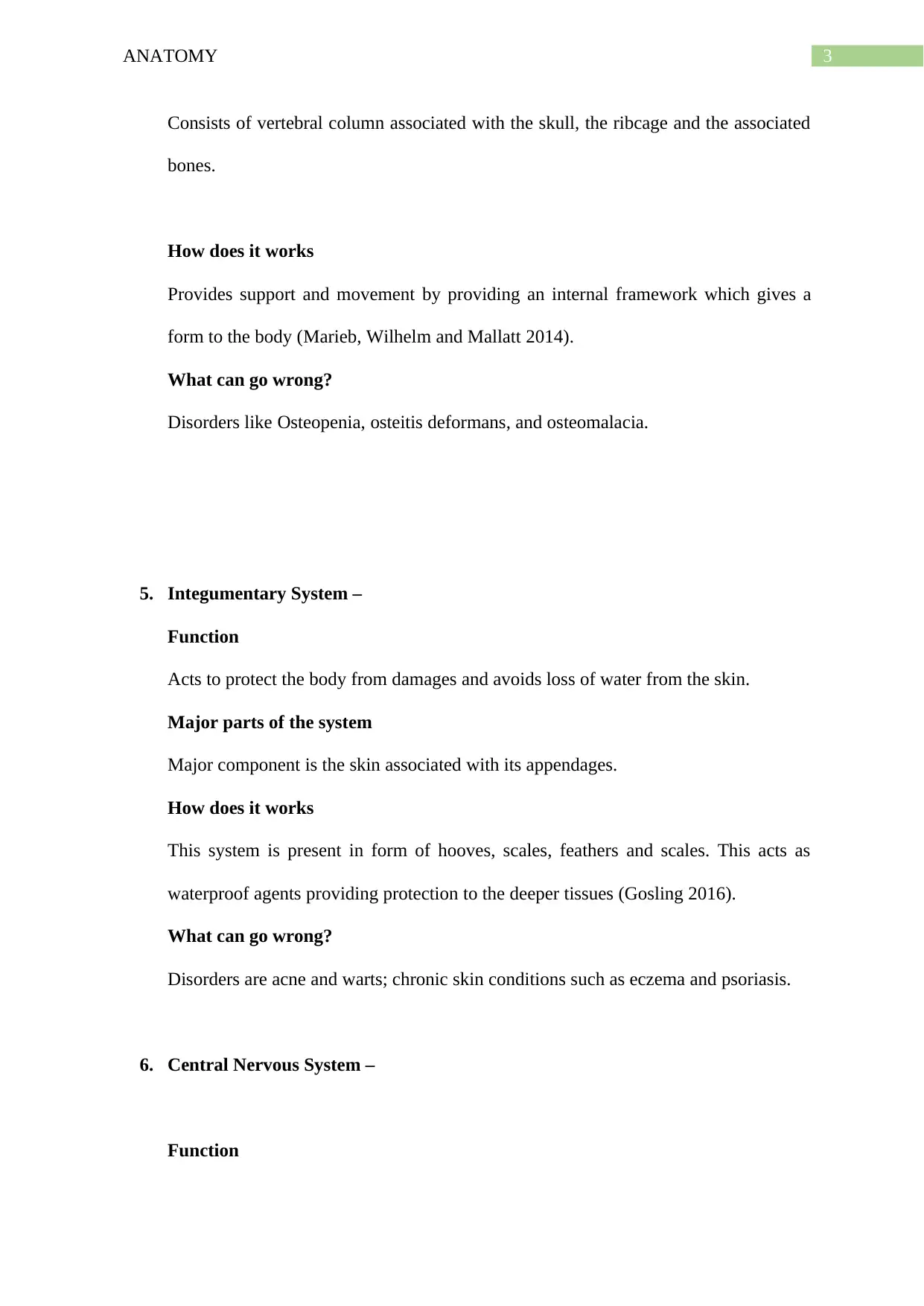
3ANATOMY
Consists of vertebral column associated with the skull, the ribcage and the associated
bones.
How does it works
Provides support and movement by providing an internal framework which gives a
form to the body (Marieb, Wilhelm and Mallatt 2014).
What can go wrong?
Disorders like Osteopenia, osteitis deformans, and osteomalacia.
5. Integumentary System –
Function
Acts to protect the body from damages and avoids loss of water from the skin.
Major parts of the system
Major component is the skin associated with its appendages.
How does it works
This system is present in form of hooves, scales, feathers and scales. This acts as
waterproof agents providing protection to the deeper tissues (Gosling 2016).
What can go wrong?
Disorders are acne and warts; chronic skin conditions such as eczema and psoriasis.
6. Central Nervous System –
Function
Consists of vertebral column associated with the skull, the ribcage and the associated
bones.
How does it works
Provides support and movement by providing an internal framework which gives a
form to the body (Marieb, Wilhelm and Mallatt 2014).
What can go wrong?
Disorders like Osteopenia, osteitis deformans, and osteomalacia.
5. Integumentary System –
Function
Acts to protect the body from damages and avoids loss of water from the skin.
Major parts of the system
Major component is the skin associated with its appendages.
How does it works
This system is present in form of hooves, scales, feathers and scales. This acts as
waterproof agents providing protection to the deeper tissues (Gosling 2016).
What can go wrong?
Disorders are acne and warts; chronic skin conditions such as eczema and psoriasis.
6. Central Nervous System –
Function
Paraphrase This Document
Need a fresh take? Get an instant paraphrase of this document with our AI Paraphraser
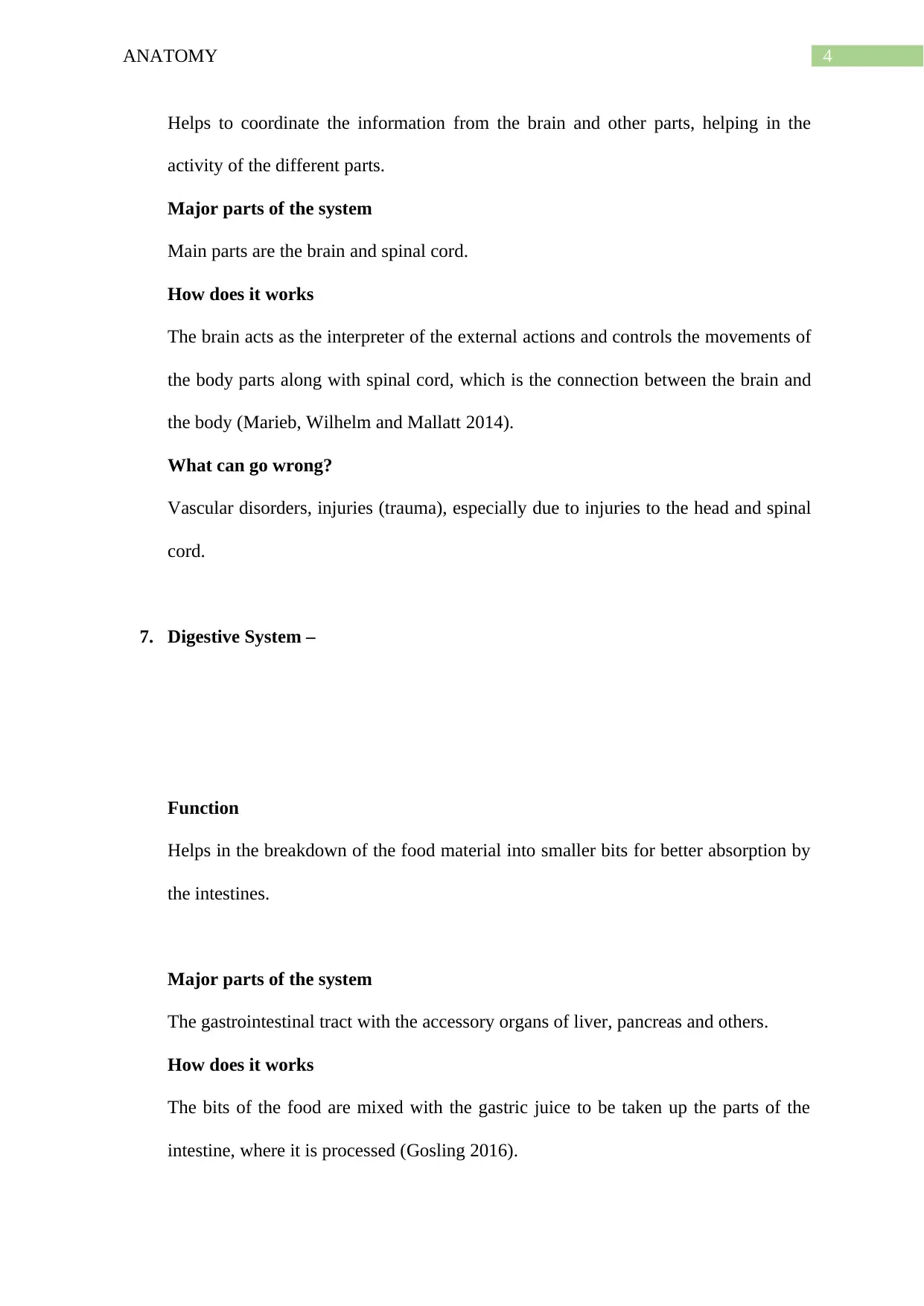
4ANATOMY
Helps to coordinate the information from the brain and other parts, helping in the
activity of the different parts.
Major parts of the system
Main parts are the brain and spinal cord.
How does it works
The brain acts as the interpreter of the external actions and controls the movements of
the body parts along with spinal cord, which is the connection between the brain and
the body (Marieb, Wilhelm and Mallatt 2014).
What can go wrong?
Vascular disorders, injuries (trauma), especially due to injuries to the head and spinal
cord.
7. Digestive System –
Function
Helps in the breakdown of the food material into smaller bits for better absorption by
the intestines.
Major parts of the system
The gastrointestinal tract with the accessory organs of liver, pancreas and others.
How does it works
The bits of the food are mixed with the gastric juice to be taken up the parts of the
intestine, where it is processed (Gosling 2016).
Helps to coordinate the information from the brain and other parts, helping in the
activity of the different parts.
Major parts of the system
Main parts are the brain and spinal cord.
How does it works
The brain acts as the interpreter of the external actions and controls the movements of
the body parts along with spinal cord, which is the connection between the brain and
the body (Marieb, Wilhelm and Mallatt 2014).
What can go wrong?
Vascular disorders, injuries (trauma), especially due to injuries to the head and spinal
cord.
7. Digestive System –
Function
Helps in the breakdown of the food material into smaller bits for better absorption by
the intestines.
Major parts of the system
The gastrointestinal tract with the accessory organs of liver, pancreas and others.
How does it works
The bits of the food are mixed with the gastric juice to be taken up the parts of the
intestine, where it is processed (Gosling 2016).
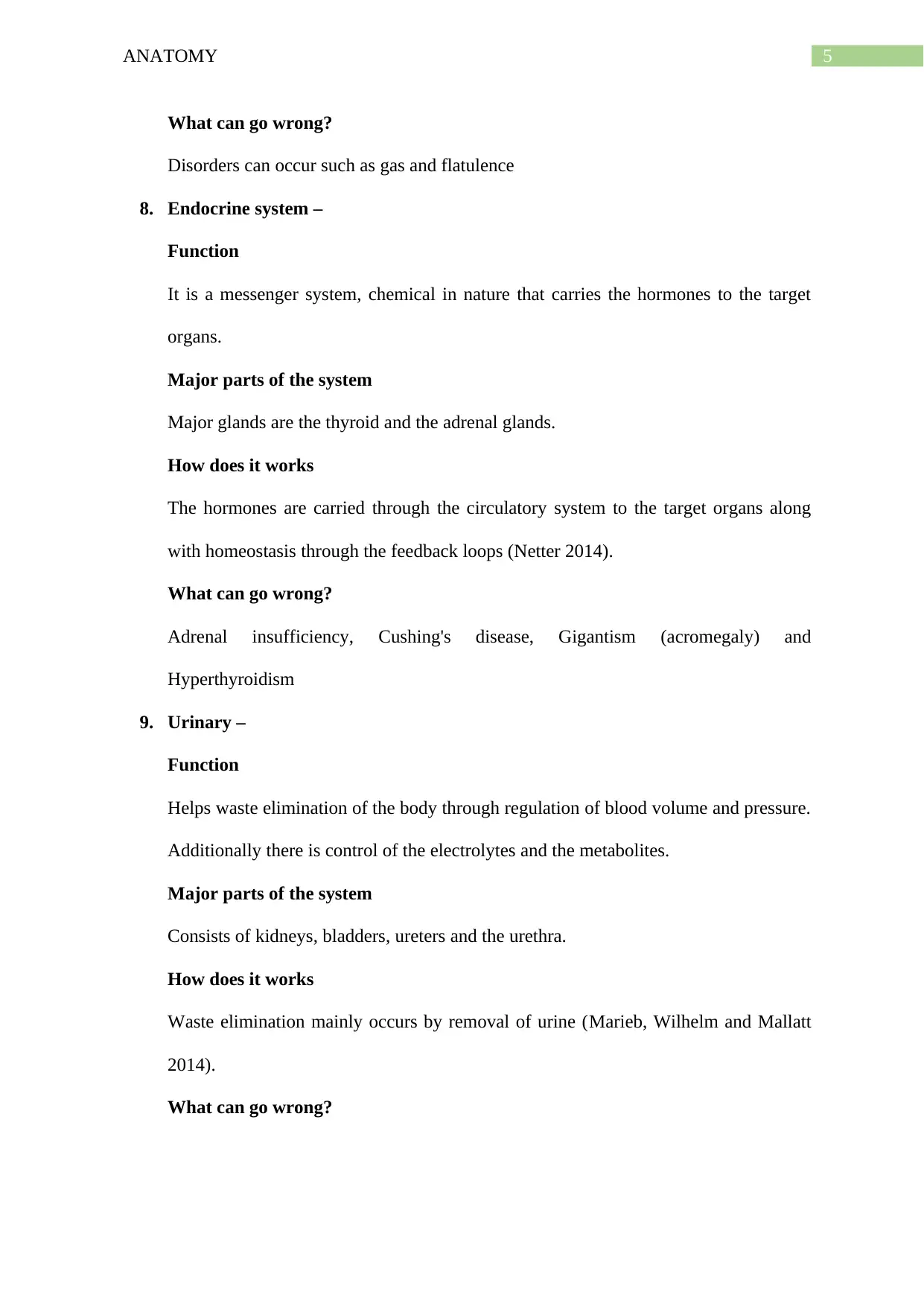
5ANATOMY
What can go wrong?
Disorders can occur such as gas and flatulence
8. Endocrine system –
Function
It is a messenger system, chemical in nature that carries the hormones to the target
organs.
Major parts of the system
Major glands are the thyroid and the adrenal glands.
How does it works
The hormones are carried through the circulatory system to the target organs along
with homeostasis through the feedback loops (Netter 2014).
What can go wrong?
Adrenal insufficiency, Cushing's disease, Gigantism (acromegaly) and
Hyperthyroidism
9. Urinary –
Function
Helps waste elimination of the body through regulation of blood volume and pressure.
Additionally there is control of the electrolytes and the metabolites.
Major parts of the system
Consists of kidneys, bladders, ureters and the urethra.
How does it works
Waste elimination mainly occurs by removal of urine (Marieb, Wilhelm and Mallatt
2014).
What can go wrong?
What can go wrong?
Disorders can occur such as gas and flatulence
8. Endocrine system –
Function
It is a messenger system, chemical in nature that carries the hormones to the target
organs.
Major parts of the system
Major glands are the thyroid and the adrenal glands.
How does it works
The hormones are carried through the circulatory system to the target organs along
with homeostasis through the feedback loops (Netter 2014).
What can go wrong?
Adrenal insufficiency, Cushing's disease, Gigantism (acromegaly) and
Hyperthyroidism
9. Urinary –
Function
Helps waste elimination of the body through regulation of blood volume and pressure.
Additionally there is control of the electrolytes and the metabolites.
Major parts of the system
Consists of kidneys, bladders, ureters and the urethra.
How does it works
Waste elimination mainly occurs by removal of urine (Marieb, Wilhelm and Mallatt
2014).
What can go wrong?
⊘ This is a preview!⊘
Do you want full access?
Subscribe today to unlock all pages.

Trusted by 1+ million students worldwide
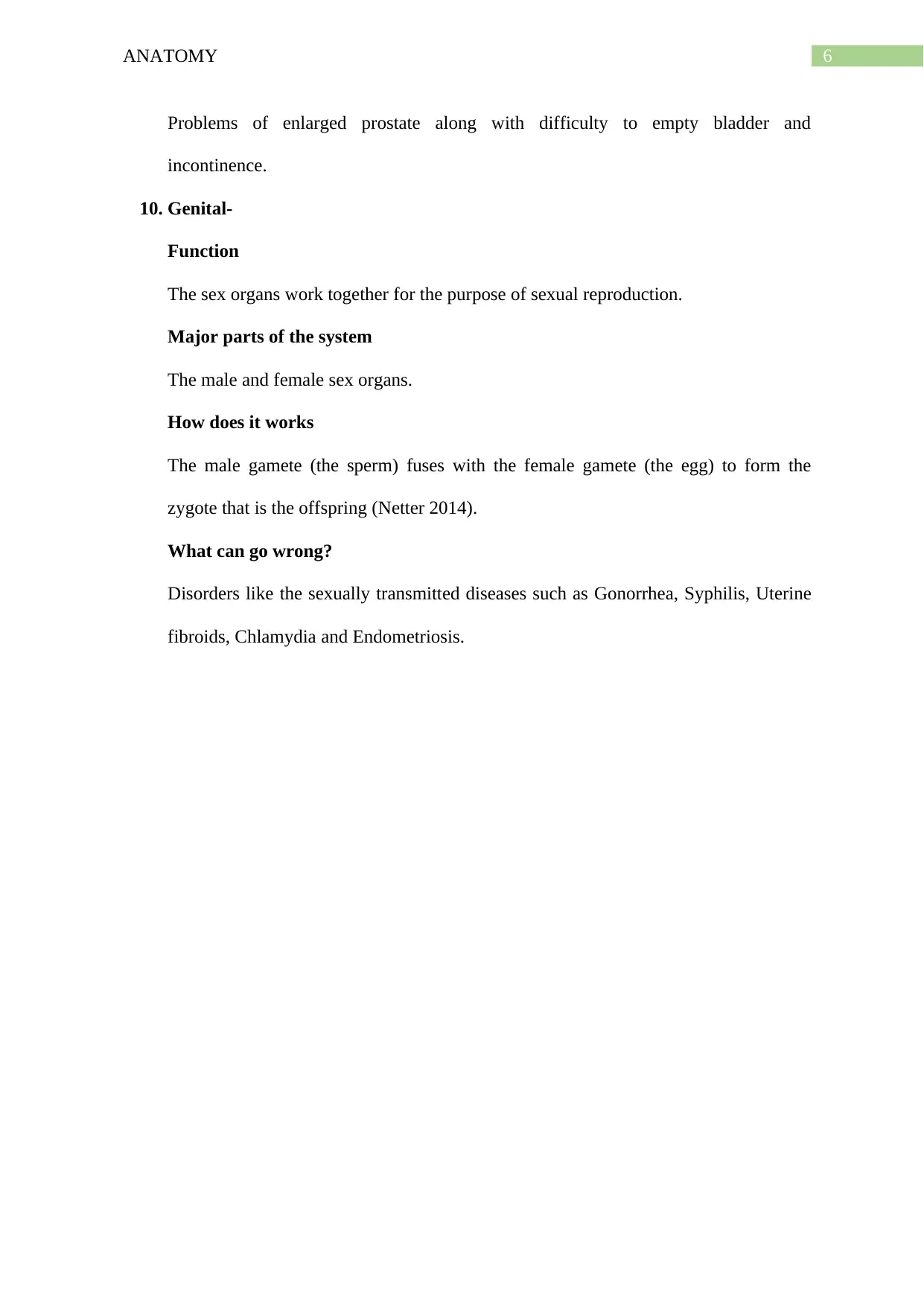
6ANATOMY
Problems of enlarged prostate along with difficulty to empty bladder and
incontinence.
10. Genital-
Function
The sex organs work together for the purpose of sexual reproduction.
Major parts of the system
The male and female sex organs.
How does it works
The male gamete (the sperm) fuses with the female gamete (the egg) to form the
zygote that is the offspring (Netter 2014).
What can go wrong?
Disorders like the sexually transmitted diseases such as Gonorrhea, Syphilis, Uterine
fibroids, Chlamydia and Endometriosis.
Problems of enlarged prostate along with difficulty to empty bladder and
incontinence.
10. Genital-
Function
The sex organs work together for the purpose of sexual reproduction.
Major parts of the system
The male and female sex organs.
How does it works
The male gamete (the sperm) fuses with the female gamete (the egg) to form the
zygote that is the offspring (Netter 2014).
What can go wrong?
Disorders like the sexually transmitted diseases such as Gonorrhea, Syphilis, Uterine
fibroids, Chlamydia and Endometriosis.
Paraphrase This Document
Need a fresh take? Get an instant paraphrase of this document with our AI Paraphraser
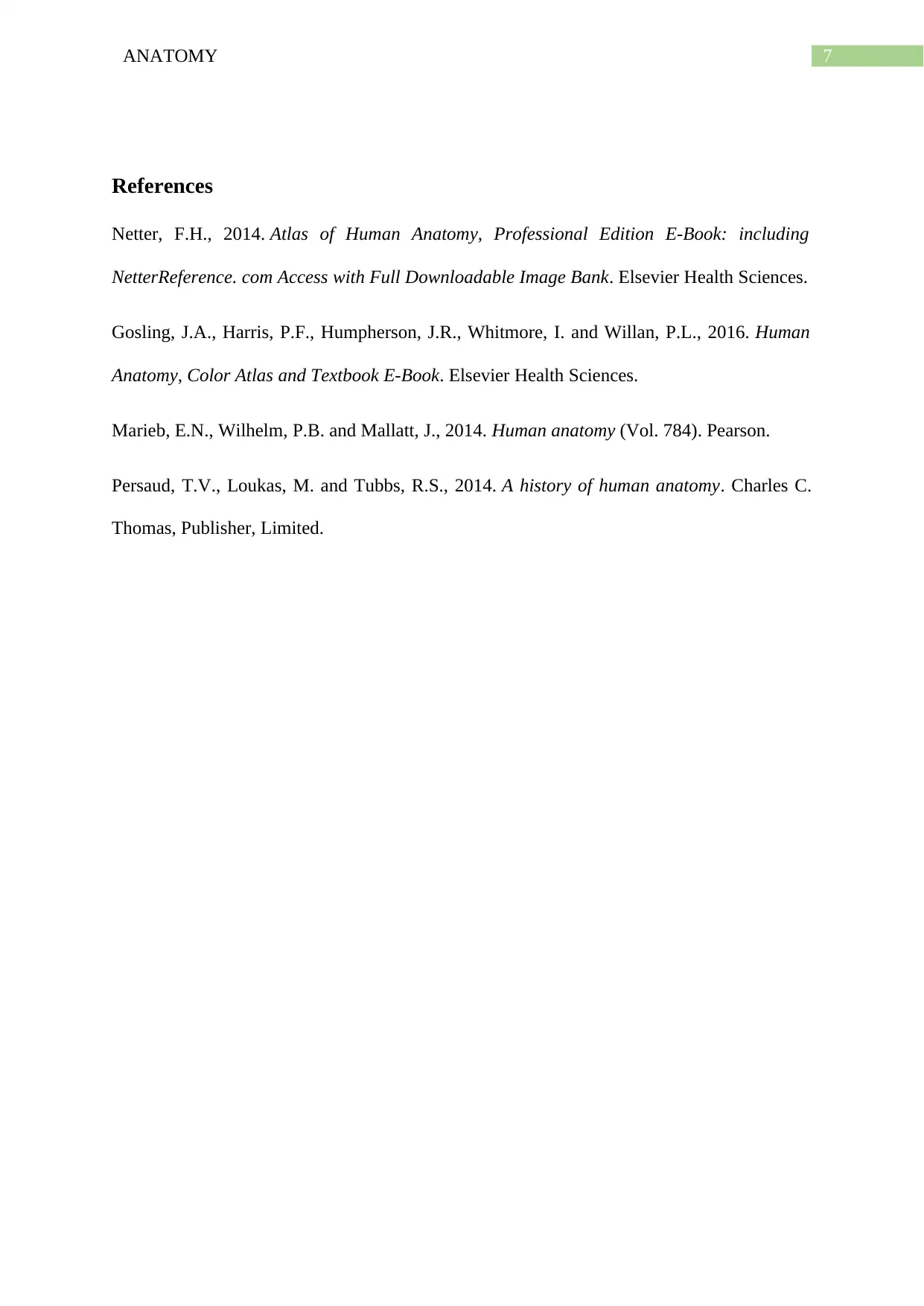
7ANATOMY
References
Netter, F.H., 2014. Atlas of Human Anatomy, Professional Edition E-Book: including
NetterReference. com Access with Full Downloadable Image Bank. Elsevier Health Sciences.
Gosling, J.A., Harris, P.F., Humpherson, J.R., Whitmore, I. and Willan, P.L., 2016. Human
Anatomy, Color Atlas and Textbook E-Book. Elsevier Health Sciences.
Marieb, E.N., Wilhelm, P.B. and Mallatt, J., 2014. Human anatomy (Vol. 784). Pearson.
Persaud, T.V., Loukas, M. and Tubbs, R.S., 2014. A history of human anatomy. Charles C.
Thomas, Publisher, Limited.
References
Netter, F.H., 2014. Atlas of Human Anatomy, Professional Edition E-Book: including
NetterReference. com Access with Full Downloadable Image Bank. Elsevier Health Sciences.
Gosling, J.A., Harris, P.F., Humpherson, J.R., Whitmore, I. and Willan, P.L., 2016. Human
Anatomy, Color Atlas and Textbook E-Book. Elsevier Health Sciences.
Marieb, E.N., Wilhelm, P.B. and Mallatt, J., 2014. Human anatomy (Vol. 784). Pearson.
Persaud, T.V., Loukas, M. and Tubbs, R.S., 2014. A history of human anatomy. Charles C.
Thomas, Publisher, Limited.
1 out of 8
Related Documents
Your All-in-One AI-Powered Toolkit for Academic Success.
+13062052269
info@desklib.com
Available 24*7 on WhatsApp / Email
![[object Object]](/_next/static/media/star-bottom.7253800d.svg)
Unlock your academic potential
Copyright © 2020–2025 A2Z Services. All Rights Reserved. Developed and managed by ZUCOL.





